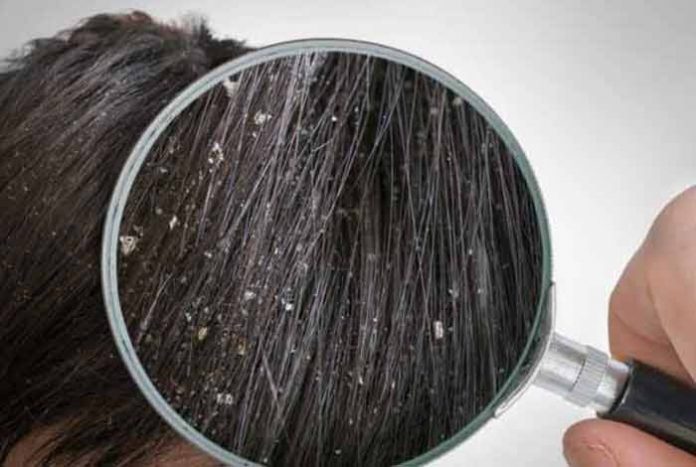
Overview and Facts
Dandruff is a chronic condition, which occurs due to dry or greasy scalp that produces flakes of dead skin cells. These flakes are found in the head or on the shoulders and can result in itching. Sometimes, frequent scratching may lead to hair fall. Although dandruff does not harm you, yet it can be embarrassing to have the condition. It originates while a person is in the age range of 10 to 20. It affects about 40% people above the age of 30.
Skin cells are continuously found on the scalp. Thus, if skin cells shed, it is a normal thing. However, dandruff makes the skin cells shed at a faster rate than usual. Sebum or oil in the scalp makes skin cells clump together and form white flakes. A more intense form of the inflammation of the skin is known as seborrheic dermatitis. So, beware of that red itchy scalp that has flaky scales. It could be seborrheic dermatitis. This condition resembles eczema, psoriasis or some allergy. In seborrheic dermatitis, redness and itchiness occur near the nose and the eyebrow areas in addition to the scalp.
Over 50 million people in the U.S. suffer from dandruff, which accounts for approximately 20% of the total U.S. population. As per Wiley Online Library, dandruff is a very common scalp disorder and affects both genders equally. It is prevalent in almost all races and ethnicities. Dandruff is more severely present in the winters and is comparatively mild in summers. It could be because of dry hair.
Nevertheless, other factors like stress or alcohol abuse could also contribute to dandruff. Also, someone having dandruff is more prone to have hair fall problem. They shed almost double the hair as compared to those, who do not have dandruff.
Types and Symptoms of Dandruff
Types of Dandruff:
Dandruff can be of following types:
- Dry Skin-Related Dandruff: Dandruff that occurs because of dry skin is a very common type. Generally, during winters, when you wash your hair with warm water, it becomes more dry and flaky.
- Oil-Related Dandruff: It is also a common cause of dandruff in which sebum or oil secreted from the scalp gets accumulated on the skin. It happens as a result for sporadic or improper washing of hair. If the scalp is unclean, sebum or skin oil gels with all the dead skin cells and dirt, giving itchy flakes.
- Fungal Dandruff: Malassezia is a fungus present on the scalp and skin. Generally, its growth is limited, but when there is excessive oil on the scalp, it favors the growth of this fungus. Malassezia gives oleic acid as a byproduct. This acid produces a lot of dead skin cells, causing white flakes.
- Disease-Related Dandruff: Some conditions like psoriasis lead to excess production of dead skin cells that result in scaly skin. Skin cells combine with dirt and sebum to cause dandruff. Eczema also makes skin flaky and itchy and may contribute to the formation of dandruff.
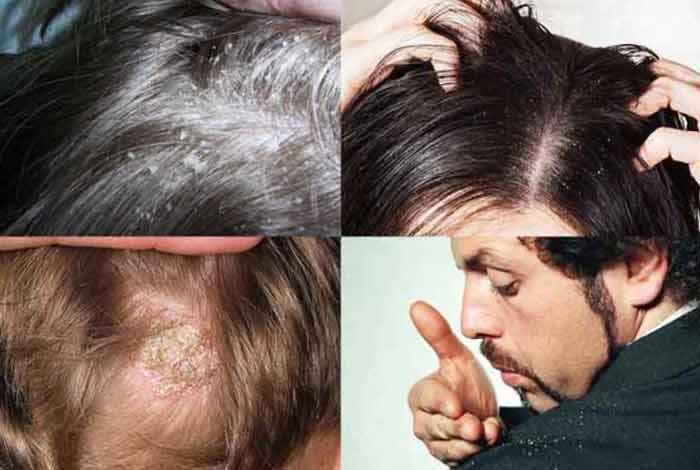
Symptoms of Dandruff:
Common symptoms of dandruff are listed as follows:
- Skin flakes that could be small and white or greasy and yellow
- Itchy flaking appearing on the scalp or eyebrows, near the nose, hairline or ears, or in the center of chest or back.
Thus, the symptoms of dandruff are white flakes of dead skin in the hair or on the shoulders. Other symptoms include itchy, red and scaly scalp. Generally, flakes of dandruff are spread throughout the scalp. Scalp becomes dry and greasy and appears itchy. As skin cells start dying, they become yellowish. These yellowish and reddish scales appear near the ears, nose and chest. Also, it may be present in newly born babies in whom a thick rash may develop on the scalp. This is known as cradle cap.
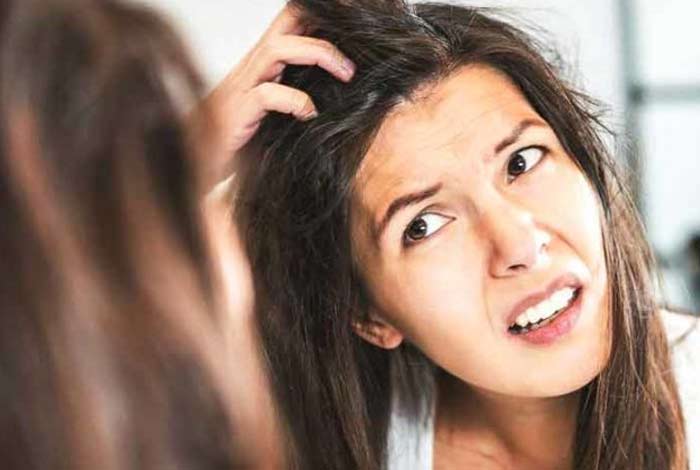
Risk Factors of Dandruff
The following are the risk factors for dandruff:
- Age: It generally starts during young adulthood and continues up through middle ages. The issue could be prolonged in some cases.
- Gender: I comparison to women, more men are found to have dandruff. It could be because of the male hormones.
- Other Health Conditions: Some adults with diseases like Parkinson’s disease have a greater likelihood of developing dandruff. It is also true for people with HIV infections or whose immune system is weak.
- Oily Hair and Scalp: The fungus Malassezia stays alive by feeding on oils present in the scalp. Because of this, there may be more dandruff in the oily hair and scalp.
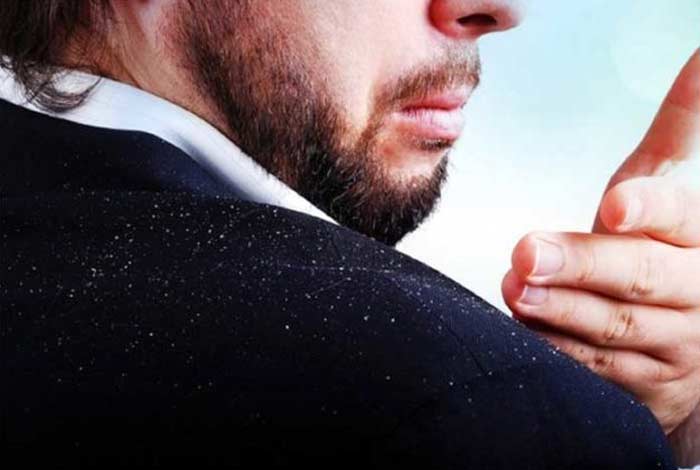
Do I have Dandruff?
If you have a dry, flaky scalp, then it may be dandruff. But, it could possibly be a sign of some other condition like dry scalp. Although the symptoms of dandruff and dry scalp are similar, i.e., itchiness and falling flakes, these two are very different conditions.
In dry scalp, skin flakes off after getting irritated. In dandruff, however, it is too much oil on the scalp, which causes shedding of the skin cells. There could be other conditions like eczema, psoriasis or any allergy, which might give dandruff-like symptoms.
Thus, it is important to consult a doctor, who would identify the right cause of the condition and suggest you the best possible treatment.

Causes and Prevention of Dandruff
Causes of Dandruff:
Various factors that could lead to dandruff are:
- Irritated and Oily Skin: This is a very common cause of dandruff. It makes the skin red and greasy, covered with white or yellow scales. It could affect your scalp and other areas like eyebrows, side of the nose and back of the ears.
- Not Shampooing Hair Often: If hair is not washed regularly, oil begins to accumulate, and skin cells start shedding, which may lead to dandruff.
- Malassezia Fungus: This fungus lives on the scalp of many adults. It irritates the scalp in some and causes growth of the skin cells. The surplus skin cells die and fall off which presents itself as white flakes in the hair or shoulders or on the clothes.
- Dry Skin: Flakes that happen from dry skin are small and generally less oily than other causes of dandruff. One will also have dry skin on other parts like arms and legs.
- Using Some Types of Hair Care Products: Sometimes, ingredients in some hair care products and dyes can cause itchy, reddish and scaly scalp.
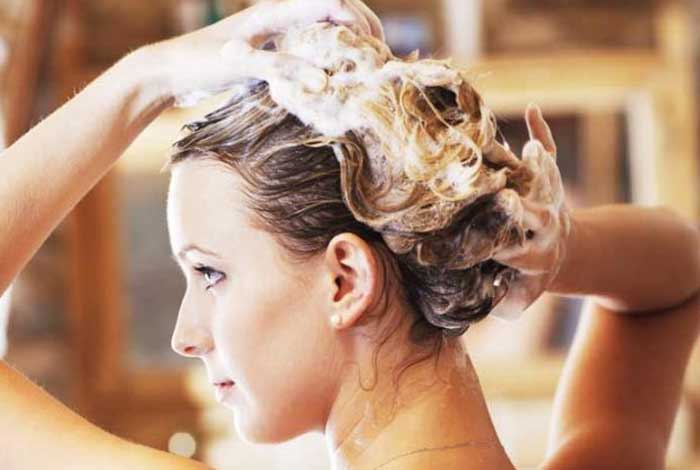
Prevention of Dandruff:
One may use an antifungal or antidandruff shampoo once a week. This may help prevent dandruff.
Also, spend time in the sun, but in limit as too much exposure to the sun may have damaging effects on the skin. Dandruff is more severe in the winter months, so the best way to increase humidity is to buy humidifiers. Make sure humidifier is clean before you use it.
Reduce stress as stress aggravates dandruff. Stress may trigger or worsen the condition of dandruff. A little modification in one’s diet can also be beneficial. When it comes to dandruff, foods containing zinc, omega-3 fatty acids and vitamin B may be beneficial.
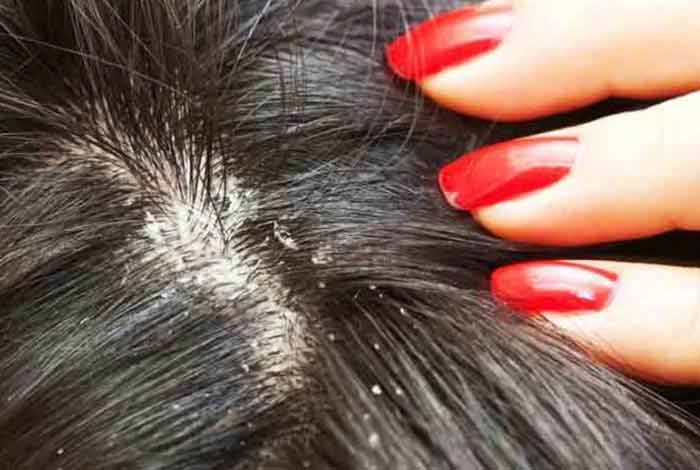
Diagnosis and Tests for Dandruff
The symptoms of dandruff are quite explicit in itself that you may not require a formal diagnosis. The dry and white flakes indicate dandruff and no medical tests may be needed to identify it.
If one sees a doctor, he/she will look at the redness and color of the scaling on the scalp for the identification of the condition. When one visits the doctor for treating the condition, he/she usually begins by examining the scalp and skin for diagnosing dandruff and identifying its cause.
Also, make sure that you intimate your doctor about the hair styling products that you are using as these may also result in dandruff.
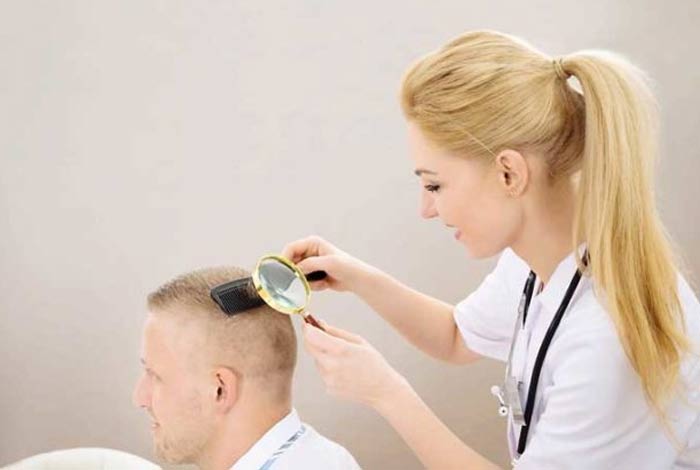
Treatment and Care of Dandruff
Dandruff, in most cases, can be controlled. In cases of mild dandruff, cleaning the head daily with a gentle shampoo for reducing oil and buildup or growth of excessive skin cells may be helpful. There are dandruff shampoos available depending on the medications they contain.
- Pyrithione Zinc Shampoos: These shampoos contain antifungal and antibacterial agent – zinc pyrithione. This type of shampoo reduces fungus on the scalp that results in dandruff.
- Tar-Based Shampoos: Coal tar helps in reducing dandruff as it slows down the rate of the death of skin cells that causes flakiness. For light colored hair, this shampoo may lead to discoloration.
- Salicylic Acid-Based Shampoos: Shampoos containing salicylic acid helps get rid of scale. However, it leaves the scalp dry, which further causes more flakiness. Using a conditioner after shampooing can be beneficial.
- Shampoos Containing Selenium Sulfide: These shampoos slow down the rate at which skin cells dry and may also reduce the fungus, Malassezia.
- Ketoconazole Shampoos: It is an antifungal agent, which generally works when other shampoos have failed. It is available over the counter (OTC) and also as prescription.
Apply these shampoos often or every day till the time your hair becomes completely free of dandruff. Once the dandruff is gone, one can still use these shampoos twice or thrice a week.
If you have religiously shampooed for many weeks, but still have not found any relief, then you must consult a doctor or dermatologist, who may suggest you a prescription-strength shampoo or treatment with steroid lotion.
OTC or Self-Management Methods for Dandruff
Over-the-Counter (OTC) Medications for Dandruff:
There are many OTC medications available for dandruff. Ketoconazole topical, topical, salicylic acid topical, coal tar topical and selenium sulfide topical are some over-the-counter medicines that can be used to treat dandruff.
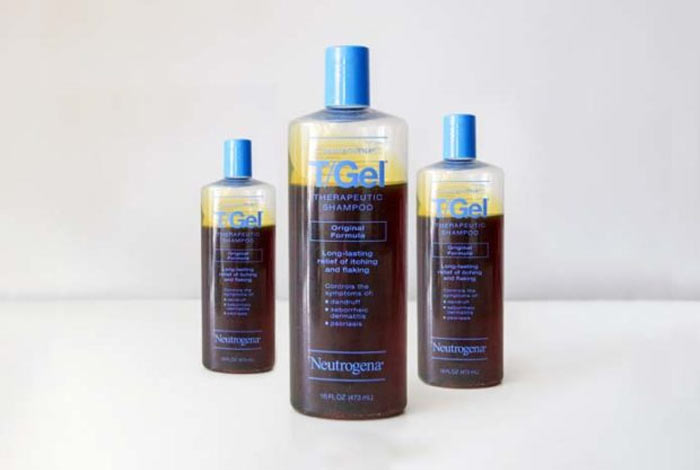
Self-Management Methods for Dandruff:
Following measures can be taken to self-manage the condition:
- Do not scratch your scalp. When you are using shampoo, gently massage your scalp without scratching, so that the hair or scalp does not get damaged.
- Brush your hair daily and wash it thrice a week. Rinse thoroughly, so that no shampoo remains in the hair. A shampoo containing tea tree oil is recommended, since it has antifungal and antiseptic properties.
- Do not use chemicals on your scalp. Chemicals decrease the number of bacteria on the scalp that are required to fight against fungal infection.
- Refrain from using hair care products like hair gel and hair sprays as these can buildup oils and irritate scalp. You may be required to change the hair care product or stop using it for a while to notice if the dandruff goes away.
- Spending time in the sun helps reduce dandruff. However, be cautious about the skin as long exposure to UV radiation can damage your skin.
- If you are managing your stress, then your chances of getting dandruff are less. Stress may trigger or worsen dandruff.
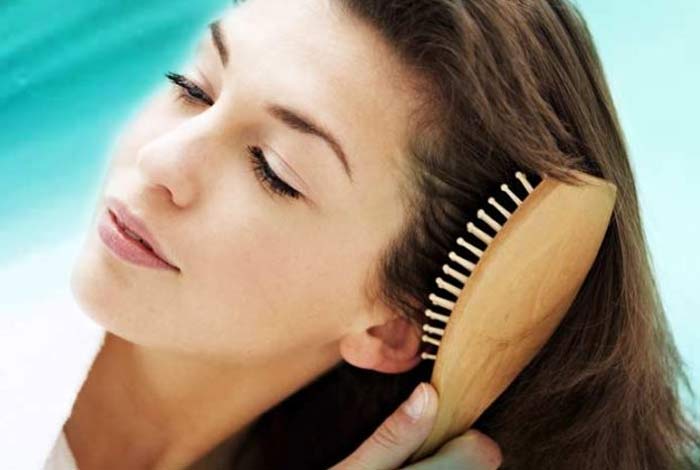
Natural Ways to Cure Dandruff
Some simple and natural remedies for treating dandruff are given below:
- Coconut Oil and Lemon Massage: Coconut oil nourishes the scalp and at the same time, lemon juice treats dandruff without the involvement of any harmful chemical. Heat about 2 tablespoons of coconut oil and mix it with an equal amount of lemon juice. Gently massage your scalp with the mixture. Let it stay for 20 minutes before you rinse it off.
- Fenugreek Pack: Soak fenugreek in water overnight. Mash the soaked fenugreek in a paste and remove the water. Apply the paste for about half an hour and then, rinse it off with a shampoo.
- Curd: Applying curd could be cumbersome, but it is highly effective in treating dandruff. Apply curd to your hair strands and let it remain for half an hour before you rinse it off with a shampoo.
- Baking Soda: It has also been used as an effective treatment for dandruff. Slightly wet your hair and apply baking soda. Leave it on for about two to three minutes and then, washing it off.
- Tea Tree Oil: It is highly effective in treating dandruff. Put a few drops of tea tree oil and spread it evenly across the scalp. Let the scalp soak it for five minutes. Then, rinse it off with a shampoo.
- Apple Cider Vinegar: Mix apple cider vinegar with equal an amount of water and after having a hair wash, apply the mixture on the wet hair. Massage your scalp and let it remain for 15 minutes before washing it off.
- Neem Juice: Neem has anti-bacterial properties. One can grind a bunch of neem leaves to form a thick paste. Apply it on the scalp for 10 minutes and wash it off with water.
- Orange Peel Pack: Take some orange peel and squeeze some lemon juice in it. Grind it into a paste and apply it for half an hour. Then, wash it off with a shampoo.
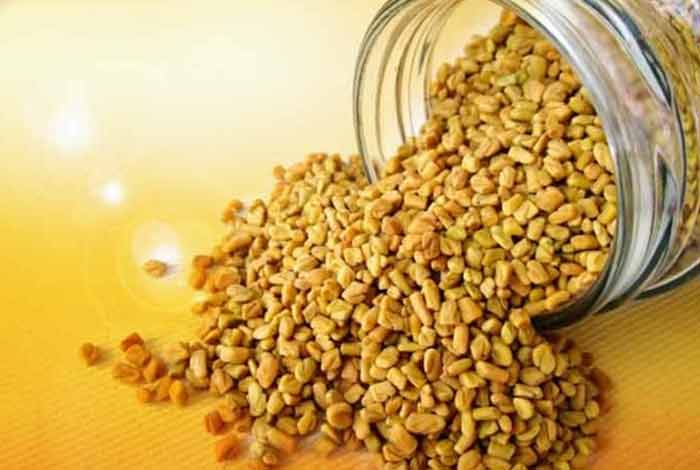
Health Tip by Expert
Spending some time in the sun, bringing about dietary modifications and using an anti-dandruff shampoo can help prevent dandruff from creeping in.





